A Dive into Kite Surf Packages: What You Need to Know
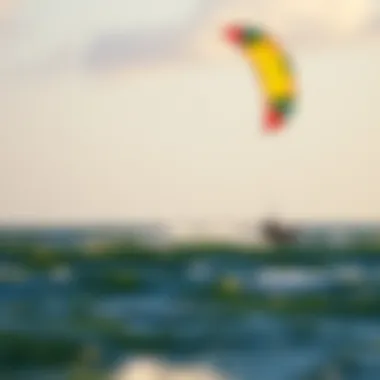
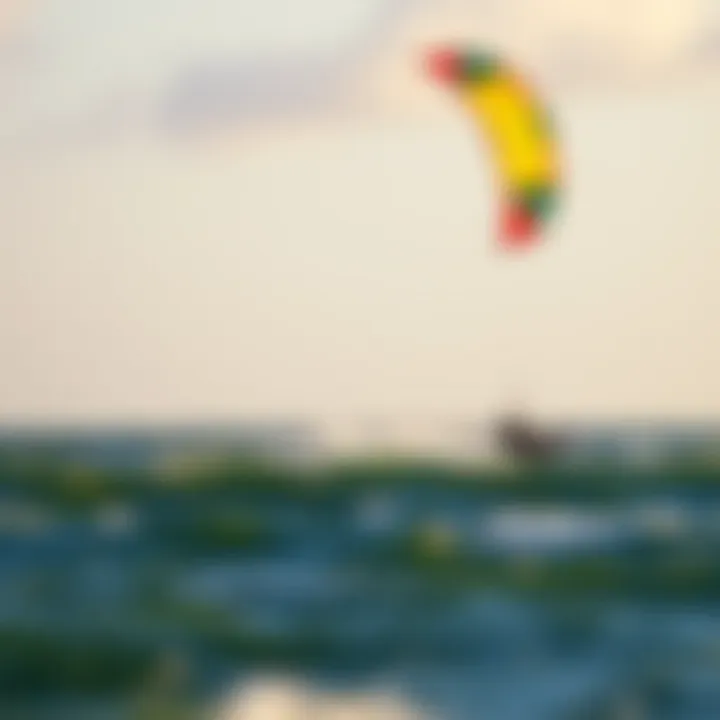
Intro
Kite surfing stands at the crossroads of thrill and skill, weaving together the excitement of surfing with the raw power of the wind. When one thinks about this adventurous sport, the images that spring to mind are often those of brightly colored kites soaring through azure skies, zigzagging across dynamic waves. But much more lies beneath the surface of this exhilarating pastime. Individuals wishing to leap into the world of kite surfing need to consider various aspects before picking a kite surf package. These packages not only incorporate essential gear but also training systems, safety protocols, and even the ideal spots to hit the waves.
In this guide, we’ll navigate the realm of kite surf packages, laying out the foundational components that define them. We'll break down what gear you require and how to maintain it, investigate techniques that cater to all skill levels, and deliver insights on choosing the right package tailored to suit your individual needs.
Without further ado, let’s plunge into our first section, Equipment Insights, where we will equip you with knowledge about the latest gear and gear maintenance.
Understanding Kite Surf Packages
Kite surfing has grown in popularity over the years, becoming not just a thrilling venture but also a catalyst for social interaction and cultural exchange among enthusiasts. Understanding kite surf packages is critical; these bundles encapsulate everything from gear to training, making them a convenient option for both beginners and seasoned riders. The right package can significantly flatten the learning curve, allowing individuals to dive into the sport without feeling overwhelmed.
Definition and Overview
A kite surf package is often a comprehensive offering that includes all necessary elements for kite surfing. Think of it as a starter kit that typically incorporates a kite, a board, harness, and sometimes even lessons. To illustrate, a package might include a 9m kite, a twin-tip board, and a harness, all tailored to your skill and the prevailing wind conditions of the selected destination. The allure of these packages lies in their inclusivity; they cater to various skill levels, from absolute beginners eager to catch their first wind, to experienced riders seeking to refine their techniques.
In essence, these packages provide not only equipment but also peace of mind, ensuring that you have the right tools to maximize your experience on the water. This overview sets the stage for understanding the specific components included in these packages, enabling you to make informed decisions while planning your kite surfing adventure.
Key Components of a Package
When delving into the specifics of kite surf packages, several key components come into play:
- Kite: The heart of kite surfing. Various types of kites are suited for differing wind conditions and rider skill levels. Foil kites, for instance, are often recommended for novices, as they offer more stability.
- Board: Choosing the right board is another crucial element. Options like twin-tip and directional boards serve different riding styles and conditions. For instance, twin-tip boards are known for their versatility, making them popular among beginners.
- Harness: This equipment connects the rider to the kite and should fit snugly yet comfortably. A good harness allows for better control and reduces fatigue while riding.
- Safety Gear: This category includes helmets and impact vests, which may seem secondary but are vital for reducing risk during practice or intense sessions.
- Lessons or Training: Often, packages come with instructional elements, offering valuable guidance from qualified instructors. This can be a game-changer for newcomers, ensuring they learn proper techniques from the get-go.
Understanding these components not only makes the selection process smoother but also guarantees a better riding experience. It allows you to identify what feels right, catering to your personal preferences and local conditions. For rides to truly resonate, knowing the ins and outs of your gear transitions from being an option to a necessity.
Essential Gear for Kite Surfing
When diving into the world of kite surfing, having the right gear is as essential as knowing how to ride the waves. Quality equipment not only enhances performance but also ensures safety and comfort on the water. Investing in the proper essentials can elevate your experience—from beginners seeking to learn the ropes to seasoned veterans who churn the sea with skill. Let’s delve into the core components of essential kite surfing gear, outlining the importance and benefits of each.
Kites: Types and Features
Kites are undoubtedly the heart of this sport. They come in various shapes, sizes, and designs, each crafted for specific conditions and skill levels. Here’s a closer look:
- Leading Edge Inflatable (LEI) Kites: These are the most popular type. They are versatile and suitable for all skill levels, making them a favorite among many kite surfers. The inflatable structure provides stability and strength, perfect for various wind conditions.
- Foil Kites: These kites, unlike LEIs, lack a rigid frame and are often lighter. They are typically used in lighter winds and offer great efficiency, but can be trickier to handle for beginners.
- Wave Kites: Designed specifically for surf conditions, these kites prioritize maneuverability and quick response. Their features help riders stay connected with the ocean, promoting a seamless experience when riding waves.
Beyond types, consider features such as kite aspect ratio and material. A higher aspect ratio kite glides better for speed, while lower ratios excel in stability. Choosing the right kite can make a significant difference in your overall experience.
Boards: A Guide to Selection
The board you ride on plays a pivotal role in how you experience the sport. Selecting the right board isn't merely about personal preference, but about matching your style and environment. Key considerations include:
- Board Size: Typically, larger boards are more stable and easier to control, making them ideal for beginners. On the contrast, smaller boards provide better performance in terms of agility, suited for experienced riders.
- Shape and Design: Boards come in twin-tip or directional shapes. Twin-tip boards allow for riders to ride in both directions, while directional boards are designed for wave riding and are better for advanced tricks.
- Material Quality: Look for boards made with durable materials like carbon fiber or fiberglass for longevity. Proper care and maintenance extend the board's life, ensuring excellent performance throughout seasons.
To put it simply, understanding your own style and the riding conditions can help you select a board that complements your skills and ambitions.
Harnesses and Safety Equipment
Safety should never take a back seat in extreme sports, and kite surfing is no exception. Equip yourself with a harness that feels comfortable yet secure, as it plays a crucial role in connecting you to the kite. There are two main types:
- Waist Harnesses: Ideal for freeriding and wave riding, these provide more mobility and are preferred by many experienced kite surfers.
- Seat Harnesses: These offer more support around the hips and are recommended for beginners or those who prioritize comfort during long sessions on the water.
In addition to harnesses, don’t skip on other safety equipment such as:
- Safety Leashes: These keep the kite under control in case of a fall.
- Helmets and Impact Vests: Protect your head and body in case of unexpected tumbles.
- Neoprene Suits: Essential in colder waters, they help maintain body temperature while also providing some level of protection against abrasions.
"Safety is not a gadget but a state of mind." — Eleanor Everet.
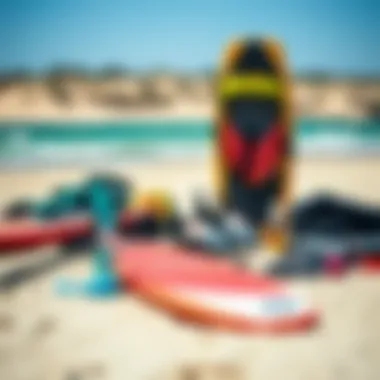
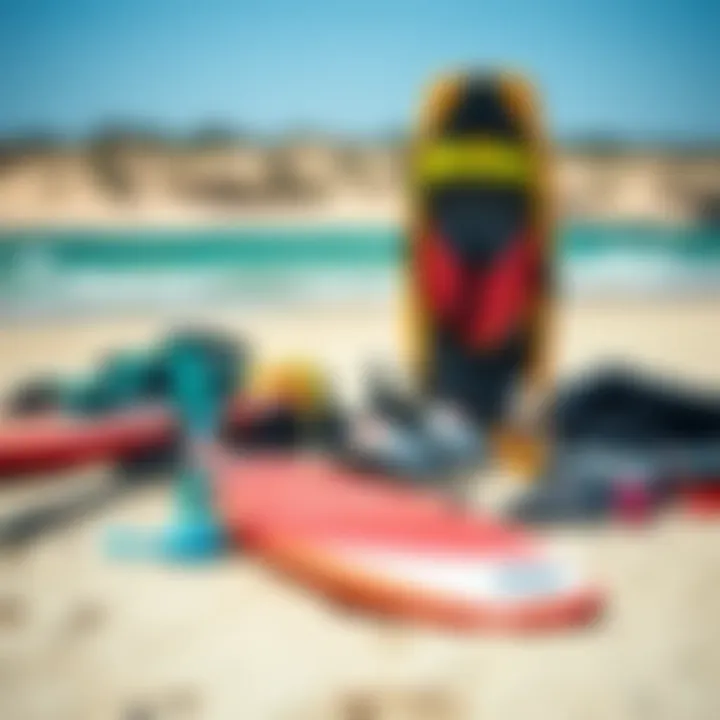
In kite surfing, having the right gear is like the quintessential difference between a smooth ride and a bumpy one. The essentials not only make an adventure memorable, they also pave the way for progression in one's skills. Every kiteboarder should carefully consider their choices to ensure a fulfilling experience on the water.
Training and Skill Development
Training and skills development sits at the heart of kite surfing. It’s not just about riding the waves or catching that perfect wind; it’s about building a solid foundation that allows you to enjoy the sport safely and with confidence. A well-structured training program equips you with the necessary techniques, enabling you to handle your equipment adeptly while understanding the dynamics of water and wind. Learning from experienced instructors and practicing consistently is key to mastering this exhilarating sport.
The Importance of Lessons
Taking lessons may seem like an initial hurdle due to cost or time, but in reality, it’s a wise investment. Kite surfing requires not just physical skills but also theoretical knowledge about winds, tides, and safety protocols. An instructor typically covers:
- The fundamentals of kite control
- Safety measures and emergency techniques
- Understanding of different wind conditions
"The more you know, the safer you'll be. Make learning a priority to truly enjoy the thrill of the ride."
Structured lessons help new kite surfers grasp complex concepts quickly, reducing the time it takes to become proficient. Moreover, learning in a controlled environment with an expert minimizes risks, allowing you to focus solely on developing skills without worrying about potential accidents.
Finding Qualified Instructors
Identifying the right instructor is crucial. Look for professionals who hold certifications from recognized bodies, like the International Kiteboarding Organization (IKO) or the International Surfing Association (ISA). These certifications often signify that an instructor has undergone rigorous training themselves and can guide you effectively.
When searching for the right instructor, consider:
- Their experience level
- Reviews and testimonials from previous students
- Their teaching style and approach
Word of mouth and online forums can be great resources to find trusted instructors. Websites such as reddit.com or facebook.com often have groups specially for kiteboarding where you can get recommendations from experienced riders. Furthermore, many kite schools offer trial lessons, allowing you to sample the instructor's teaching method before committing to a full course.
Progressing Your Skills
Once you've mastered the basics, progression doesn't stop there. Kite surfing is a sport where there's always room to grow your skills. Here are several ways to advance:
- Identify Goals: Whether it’s performing tricks or improving your speed, setting clear objectives helps keep you motivated.
- Practice on Different Waters: Each location offers unique challenges. Varying your practice environment helps you adapt and hone your skills further.
- Join Local Clubs: Engaging with a community can provide support, motivation, and plenty of tips from fellow enthusiasts.
So, invest time in learning. Every session, whether a hot success or a clumsy tumble, adds to your experience as a kite surfer. Over time, you’ll build not just technique but also the confidence to handle your gear and embrace the unpredictable nature of kite surfing.
This commitment to continuous learning will not only lead you to become a proficient kite surfer but will also deepen your appreciation for this captivating sport.
Choosing the Right Kite Surf Package
Selecting the appropriate kite surf package is more than just picking a fancy kite and board. It's about aligning your personal experience, skill level, and budget with the many offerings out there. Making the right choice enriches the whole experience, ensuring not only enjoyment but also safety on the water. This segment serves to illuminate essential factors that assist in the decision-making process when selecting a kite surf package.
Assessing Your Skill Level
Understanding where you stand in your kite surfing journey is critical. Are you a novice still getting used to the board or an experienced rider carving up the waves? Evaluating your skill level helps narrow down options tailored to your abilities.
- Beginners might want packages offering simpler kites, perhaps with a larger surface area to catch the wind easily. Kites like the Naish Switch often provide easier handling for newcomers.
- Intermediate riders could look at setups that offer a variety of kites for changing conditions, ideally something like the Cabrinha Drifter which adapts well.
- Advanced surfers may want specialized equipment that caters to tricks and high-performance riding, making brands like F-One Bandit more appealing.
In addition, local kite schools often bundle lessons with equipment rentals, helping beginners find their footing while getting the chance to use appropriate gear.
Understanding Package Features
Once your skill level is sorted, the next big piece of the puzzle is package features. The components included in the kite surf package can vary widely and influence your experience considerably. It's vital to know what you're getting into. Key features usually encompass:
- Kite Type: As mentioned, kites differ in design and purpose. Recognizing the right type for your level—be it a delta kite for ease of use or a C-kite for performance—can ensure your package aligns with your aspirations.
- Board Specs: Length, volume, and flex define how the board handles. Wide boards with more volume can be forgiving for learners, while experienced riders might prefer a tapered design for speed and maneuverability.
- Additional Accessories: Packages might include harnesses, safety leashes, or repair kits, which could save you money and hassle in the long run.
Every bit of detail in these components contributes to enhancing your kite surf adventure, so pay close attention to what's listed.
Cost Considerations
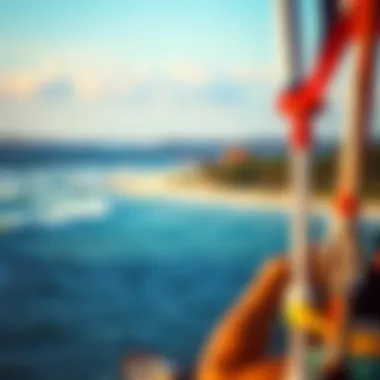
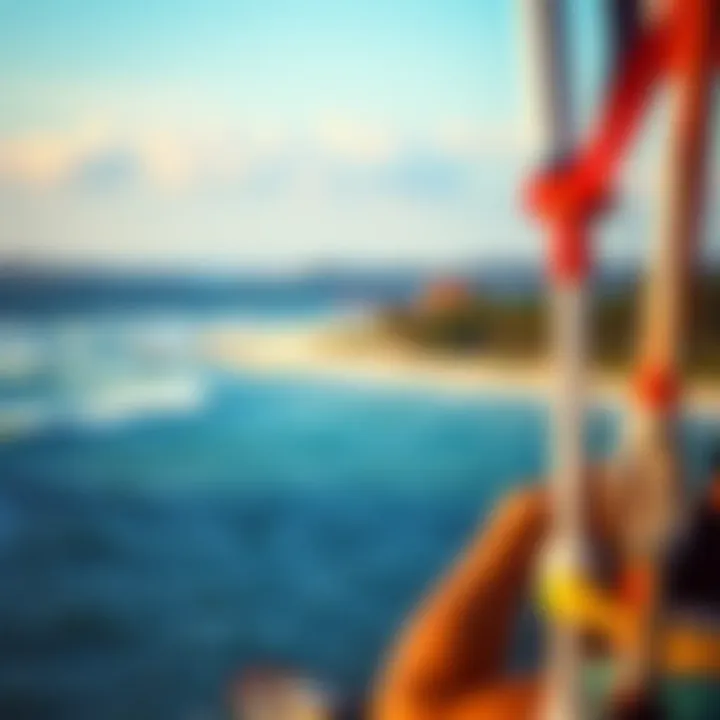
Cost plays an undeniably important role in making choices. Kite packages differ wildly in pricing, based on quality, brand, and included features. When budgeting for kite surfing:
- Look at what’s included. A slightly pricier package that offers all necessary gear can be far better than a cheaper one with just a kite and board.
- Consider long-term investment. Quality gear may seem a steep upfront investment but could save you from the constant need to replace subpar equipment.
- Explore discounts and deals. Purchasing off-season or bundles can sometimes unlock better pricing. Plus, sites like Kiteforum often have great community buzz about second-hand deals that might fit your needs while being easier on the wallet.
Navigating costs might take a bit of elbow grease, but finding a package that ticks all your boxes for a reasonable price is worth it.
"The journey of kite surfing is as thrilling as the ride itself; choosing the right package sets the course for that adventure."
Popular Kite Surf Destinations
Understanding where to kite surf can greatly enhance your experience and skill level. Kite surf destinations offer more than just beautiful views; they provide essential wind patterns, water conditions, and local communities that can impact both your enjoyment and safety. Whether you’re a seasoned kiteboarder or just starting out, knowing the right places to go can make all the difference.
Top Locations Globally
When it comes to widely recognized kite surf spots, a few locations consistently make the top of the list due to their ideal conditions and vibrant communities. Some notable mentions include:
- Tarifa, Spain: Known for its strong and consistent winds, Tarifa attracts kite surfers from around the world. The blend of Mediterranean sun and Atlantic winds creates an inviting playground for both beginners and pros. Plus, its lively beach culture keeps spirits high.
- Nassau, Bahamas: This beautiful location offers crystal clear waters and steady wind, perfect for those looking to kite surf in paradise. The lack of large crowds allows for a more personalized experience on the water.
- Mui Ne, Vietnam: A lesser-known but fantastic spot, Mui Ne provides strong winds during the dry season and a charming local culture. The flat waters make it beginner-friendly, while the wind conditions entice experienced surfers.
- Hood River, Oregon: If you prefer fresh water, Hood River is famous for its excellent wind conditions and stunning natural scenery. It’s a great year-round destination, often buzzing with local kiteboarding events.
Each of these locations has distinct characteristics, but they all share a reputation for being havens for kiteboarders, offering reliable wind and inviting waters.
Hidden Gems for Kiteboarders
While the popular destinations have their allure, some hidden gems can provide a more unique and serene experience. These spots may not attract the same crowds, allowing for a less commercial feel and a chance to focus on your skills. Here are a few:
- El Gouna, Egypt: Tucked away in the Red Sea, El Gouna boasts flat waters and consistent winds. The natural beauty of the area, combined with great facilities, makes it an underrated kiteboarding destination.
- Dahab, Egypt: Known as a chill kitesurfing town, Dahab hosts incredible spots both for beginners and seasoned surfers. The local community is warm and welcoming, creating a great atmosphere to immerse in the kiteboarding culture.
- Cumbuco, Brazil: Perfect not just for its conditions but also for its stunning lagoons, Cumbuco offers kite surfing amidst breathtaking scenery. Additionally, the local food scene adds to the overall experience, making it a delightful trip beyond just the sport.
In choosing kite surf locations, always check ahead for the best times to visit based on wind conditions and tide patterns. Also, remember that local etiquette and knowledge of the area can enhance your time on the water.
"The right destination can elevate your skills and unleash your true kiteboarding potential. Beyond the thrill of the ride lies the joy of the journey."
For more information on top kiteboarding spots, consider visiting relevant community forums or resources like reddit.com or kitesurfing.org to connect with fellow surfers and seek their advice on hidden gems.
Safety Practices in Kite Surfing
Engaging in kite surfing offers exhilarating thrills, but it also carries certain risks. Practicing safety is not just a good idea; it's absolutely vital for anyone sliding across the water with a large kite overhead. Ignoring safety measures can lead to accidents that might diminish the joy of this otherwise spectacular sport. Thus, this section delves into elements that are essential to ensuring a secure and enjoyable kite surfing experience.
Understanding Weather Conditions
The weather can be your best friend or worst enemy when it comes to kite surfing. Knowing how to read weather conditions is fundamental. For instance, wind speed is a crucial factor. An ideal wind speed ranges between 12-25 knots for most riders. Going over this range can lead to overpowering situations that are risky for even skilled riders.
A common rule of thumb is: if you're being blown off course constantly, it may be time to land your kite and wait for a better day. Gale winds or sudden weather changes can cause serious hazards. Before heading out, check local forecasts and enlist apps like Windy or SailFlow, which provide real-time updates on conditions.
Equipment Checks and Maintenance
Just like checking your boot laces before a run, inspecting your kite equipment is essential for a safe ride. Start by examining the kite bag and lines for any frays or damages. A minor tear can lead to disastrous results out in the surf. Here are routine checks to always carry out:
- Kite Check: Look for holes or tears, ensure valves are functioning.
- Line Inspection: Lines should be untangled, without any knots, nicks or frays.
- Bar Condition: Ensure the depower system works smoothly without any sticking.
Furthermore, regular maintenance can extend the lifespan of your gear. After each session, rinse saltwater off your equipment, and dry everything thoroughly. This can help avert wear from the corrosive properties of salt.
Emergency Protocols
Even with all precautions, the unexpected can happen. A solid plan for emergency situations can make all the difference. No one wants to think about being in a tight spot, but being prepared is half the battle. Essential protocols include:
- Buddy System: Always kite surf with a partner. Posting in pairs can help in emergencies.
- Communication: Knowing hand signals or using waterproof radios helps when verbal communication is impossible amid wind noise.
- Safety Releases: Familiarize yourself with the quick release system on your harness. In case of trees or other obstacles suddenly appearing in your path, the quick release allows you to detach from the kite instantly.
"Preparation is the key to safety. Knowing how to react when the unexpected happens can prevent chaos from turning into catastrophe."
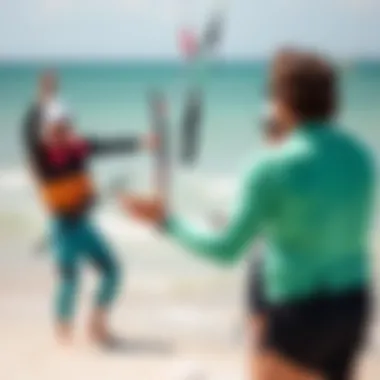
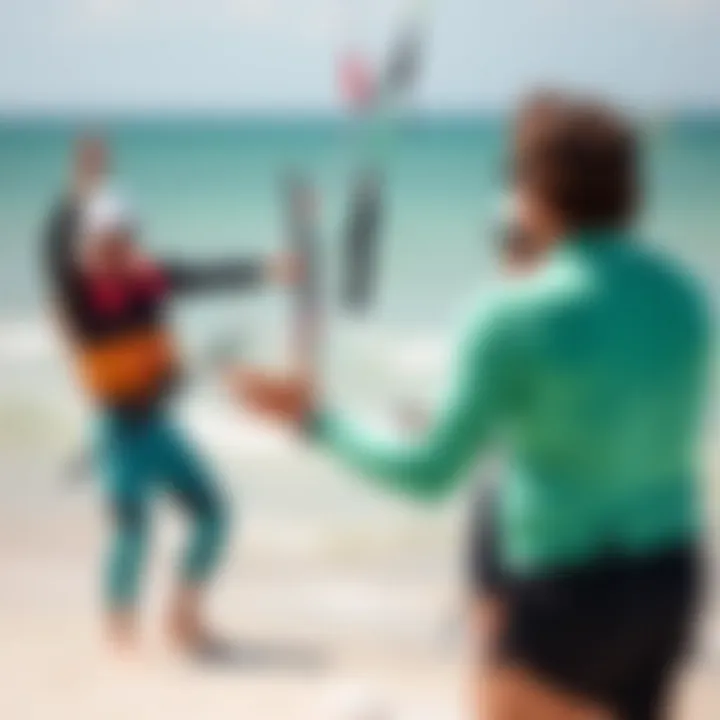
Finally, it's important to stay updated on local regulations and guidelines for kite surfing within your area. Some places will have specific beach rules or designated launch areas; familiarize yourself with those.
By prioritizing safety practices, you ensure a memorable experience while enjoying the thrill and freedom that kite surfing has to offer.
The Environmental Impact of Kite Surfing
Kite surfing, while offering exhilarating experiences on the water, does come with its own set of environmental implications. As kiteboarders zipping through waves become more common, the sport's ability to coexist harmoniously with natural ecosystems becomes a pivotal conversation. Understanding the impact can shape better practices among enthusiasts and ensure the longevity of beautiful coastal environments that we cherish.
Sustainable Practices
Adopting sustainable practices in kite surfing isn't just responsible, it's essential. Here are some practices that kiteboarders can embrace to lessen their impact on the environment:
- Choose Eco-Friendly Gear: Opt for equipment made from recycled materials or brands committed to sustainability. For instance, some manufacturers create boards from bio-resins, which reduce harmful emissions.
- Minimize Waste: Be a good steward of the environment by using a repair kit for minor damages instead of tossing out gear. Wherever possible, choose to recycle or repurpose older equipment.
- Leave No Trace: After a day on the water, it’s important to take all personal items and trash with you. Keeping the beaches clean helps preserve wildlife habitats and ensures natural beauty for everyone.
"Every small effort counts! Reduction in plastic and waste can preserve our coastlines for future generations."
- Respect Wildlife: Whether boisterous dolphins or nesting birds, understanding and respecting local wildlife is paramount. Maintain a safe distance to avoid disrupting their natural behavior, especially during breeding seasons.
Educating fellow riders about these practices spreads awareness, creating a culture of respect toward nature within the kite surfing community.
Conservation Efforts in Popular Spots
In many renowned kite surfing destinations, conservation efforts are underway to protect fragile ecosystems. Here’s a glimpse into some noteworthy initiatives:
- Beach Clean-Up Drives: Many kite surfing communities organize regular beach clean-ups. These events not only tidy up the coastal areas but also foster a sense of camaraderie among local kiteboarders and their families.
- Collaborations with Conservation Groups: Partnerships between local shops and conservation organizations have proven beneficial. In places like Cabarete in the Dominican Republic, shops often contribute a percentage of sales to local marine protection efforts.
- Awareness Campaigns: Engaging kite surfers in awareness campaigns about the importance of marine habitats and conservation can go a long way. Communities host forums discussing how protective policies benefit both nature and the sport, encouraging a thriving environment for all.
- Sustainable Tourism Practices: Popular kite destinations are implementing tourism practices that prioritize the well-being of the environment. This includes regulating the number of kite surfers in sensitive areas during peak seasons to avoid overcrowding.
By supporting such initiatives, kite surfers can actively contribute to preserving the pristine conditions of the beaches and waters they enjoy.
Community and Events in Kite Surfing
The importance of community and events in kite surfing can’t be overstated. They create a vibrant ecosystem around the sport, fostering camaraderie among kiteboarders regardless of their skill level. Getting involved in local clubs and attending events not only helps improve skills but also deepens the understanding of this exciting sport.
Staying connected with fellow enthusiasts enhances the learning experience and adds layers of enjoyment to this thrilling activity. Whether you’re a novice still finding your footing or a seasoned rider catching waves across the globe, the community serves as a backbone, providing support and motivation to push beyond personal limits.
Local Clubs and Organizations
Local clubs and organizations play a pivotal role in nurturing the kite surfing community. They often act as the lifeblood of the sport, offering a welcoming space where individuals can gather, share experiences, and learn from each other. These clubs typically organize regular meet-ups, training sessions, and have a wealth of resources that can be immensely helpful for both beginners and advanced riders.
- Skill Development: Many local clubs offer workshops that focus on improving technical skills. Whether it’s basic training for newcomers or advanced tricks for seasoned pros, these sessions can really help riders refine their craft.
- Networking Opportunities: Becoming a member of these organizations opens up pathways to meet like-minded individuals. This networking can lead to shared trips, training buddies, and even lasting friendships.
- Access to Equipment: Some clubs maintain a supply of rental gear, giving those new to the sport a chance to try kite surfing without the hefty price tag.
"Joining a local kite surfing club can be the key to unlocking your potential in the water," emphasizes Diego, a passionate kiteboarder from California, illustrating the benefits of community involvement.
Competitions and Gatherings
Competitions and various gatherings within the kite surfing landscape present thrilling opportunities for both participants and spectators. These inclusive events range from local contests at the beach to grand international championships, showcasing some of the best talent in the sport.
- Skill Showcasing: Competitions provide a platform for riders to showcase their abilities and challenge themselves amidst peers. Watching others push the envelope can inspire participants to also step up their game and try new techniques.
- Community Spirit: Gatherings often echo a festival vibe, promoting a sense of belonging and shared passion. They can be a whirlwind of excitement, with activities, music, and food, all while celebrating the sport.
- Learning through Observation: For spectators, these events can function as practical learning experiences. Observing high-level competitors can impart valuable lessons on aspects such as technique, style, and strategy.
The End and Future Trends in Kite Surfing
The Evolution of Equipment
The evolution of kite surfing equipment has been nothing short of remarkable. As the sport gained traction, manufacturers began to respond to the needs and preferences of kiteboarders with advancements that directly influence performance and safety.
- Materials: Modern designs often boast cutting-edge materials like ripstop nylon or high-tenacity polyester, ensuring durability while minimizing weight. Enhanced materials have allowed kites to become more responsive and swift.
- Designs: Kite shapes have diversified significantly, with brands such as Naish and Cabrinha producing models tailored for different conditions and skill levels. Each new design is a balance of stability and agility, crafted for various wind speeds and wave sizes.
- Accessories: New gear, including inflatable harnesses and quick-release systems, provide safety and comfort to riders. Versatile designs are tailored to go easy on the body, making the sport more accessible for newcomers.
The foiling revolution has also played a significant role in the transformation of equipment, where hydrofoils have become a game-changer. By raising the board above the water, they allow riders to experience a different sensation altogether, often described as 'gliding.' This has opened up fresh vistas for kite surfers to explore, where riding in lighter winds becomes more feasible. The melding of innovation and rider feedback is laying the groundwork for future progress.
Growth of the Kite Surfing Community
A significant part of kite surfing's evolution involves community growth. The surge in popularity has led to the establishment of clubs and organizations that foster camaraderie among kiteboarders. Local meet-ups, skill-sharing workshops, and friendly competitions break down barriers and encourage enthusiastic participation.
- Global Networks: Online platforms, such as forums on Reddit and Facebook groups, offer spaces for kite surfers to connect, share experiences, and dispense advice. As kite surfing transcends geographical barriers, these platforms serve as vital exchange hubs.
- Inclusivity: Increased awareness of inclusivity has also shaped kite surfing's growth. Various initiatives aim to make the sport accessible to underrepresented groups, providing opportunities to learn and engage in new ways. The expansion of adaptive kite surfing programs emphasizes the sentiment that anyone can ride the waves, regardless of physical capabilities.
- Events: Signature competitions like the Red Bull King of the Air and regional festivals draw worldwide attention, showcasing impressive talent and pushing the boundaries of what kite surfing can achieve. These gatherings fuel community spirit, inspire up-and-coming talents, and provide a platform for the sport to gain fresh followers.
In summary, kite surfing is not just a sport; it is a dynamic community growing day by day. By nurturing relationships, leveraging technology, and remaining conscious of environmental impacts, the kite surfing scene is set for an exciting future. The lessons learned today will guide the next wave of kite surfers, ensuring that both the sport and its community continue to thrive for years to come.







